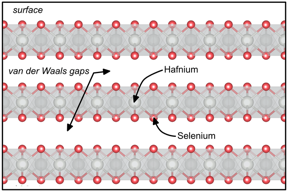Home > Press > New road towards spin-polarised currents
 |
| Hafniumdiselenide is a quasi twodimensional material with interesting properties for spintronics. Here, its crystal structure is shown.
CREDIT O. Clark/HZB |
Abstract:
The second half of the 20th century was the age of electronics, electronic devices became miniaturised and even more complex, creating problems by their energy consumption and waste heat. Spintronics promises to store or transport information based on spins alone, which would work faster with much less energy. Unfortunately it is still a challenge to control spin in a material by external fields reliably and at scale.
New road towards spin-polarised currents
Berlin, Germany | Posted on September 9th, 2022
Quasi 2D-materials in the focus
The transition metal dichalcogenide (TMD) series are the most intensely studied quasi two-dimensional materials beyond graphene, with charge density waves, superconductivity and non-trivial topological all commonplace across the material family. Hafnium diselenide (HfSe2) belongs to this class of materials. Now scientists at BESSY II have unveiled a new property of its electronic structure that could lead to a more convenient route to generate and control spin currents.
In order to shift from electronics to spintronics, we have to find materials wherein spin up and spin down electrons behave differently, first author Oliver Clark explains. There are two ways to do this, he points out: We can either externally perturb the material so that electrons of different spins become functionally inequivalent, or we can use magnets where the electrons of opposite spins are functionally different intrinsically. For the first method, the difficulty lies in finding suitable pairings of materials and mechanisms by which spin control can be externally imposed. For example, in the so-called 2H structured TMDs, one needs perfect single crystals and a circularly polarised light source. By contrast, the second method is much easier, but integrating magnets into devices is problematic for the operation of conventional electronic components, especially on small scales.
Linearly polarised light does do the trick
But between those two ways, a middle ground exists, at least for some select materials such as HfSe2:If you probe this material with linearly-polarised light which is easier to produce than circularly polarised light – the material acts as a magnet in terms of its spin-structure. So the spin-selectivity becomes very easy, but you do not have the problems associated with other magnetic properties, Clark explains. The advantage: Crystal quality or orientation of the sample no longer matter.
This provides an entirely new route towards the generation of spin-polarised currents from transition metal dichalcogenides. The physicists are very excited about the implications of this work: Our results are of relevance not only to physicists concerned with layered two-dimensional materials, but as well to specialists in spintronic and opto-spintronic device fabrication, Clark hopes.
####
For more information, please click here
Contacts:
Antonia Roetger
Helmholtz-Zentrum Berlin für Materialien und Energie
Office: 0049-308-062-43733
Copyright © Helmholtz-Zentrum Berlin für Materialien und Energie
If you have a comment, please Contact us.
Issuers of news releases, not 7th Wave, Inc. or Nanotechnology Now, are solely responsible for the accuracy of the content.
News and information
![]()
Multi-institution, $4.6 million NSF grant to fund nanotechnology training September 9th, 2022
![]()
Modified microwave oven cooks up next-gen semiconductors September 9th, 2022
![]()
New catalyst offers a more affordable way to produce hydrogen from seawater September 9th, 2022
2 Dimensional Materials
![]()
Buckyballs on gold are less exotic than graphene July 22nd, 2022
![]()
Solving the puzzle of 2D disorder: An interdisciplinary team developed a new method to characterize disorder in 2D materials June 17th, 2022
![]()
UBCO researchers change the game when it comes to activity tracking: Flexible, highly sensitive motion device created by extrusion printing June 17th, 2022
Possible Futures
![]()
Multi-institution, $4.6 million NSF grant to fund nanotechnology training September 9th, 2022
![]()
Modified microwave oven cooks up next-gen semiconductors September 9th, 2022
![]()
Lattice distortion of perovskite quantum dots induces coherent quantum beating September 9th, 2022
Spintronics
![]()
Photoinduced large polaron transport and dynamics in organic-inorganic hybrid lead halide perovskite with terahertz probes July 8th, 2022
Chip Technology
![]()
Modified microwave oven cooks up next-gen semiconductors September 9th, 2022
![]()
Lattice distortion of perovskite quantum dots induces coherent quantum beating September 9th, 2022
Quantum Computing
![]()
Quantum computer works with more than zero and one: Quantum digits unlock more computational power with fewer quantum particles July 22nd, 2022
![]()
Optical demonstration of quantum fault-tolerant threshold July 8th, 2022
Optical computing/Photonic computing
![]()
High-speed random number generation using self-chaotic microcavity lasers August 26th, 2022
Discoveries
![]()
New cathode design solves major barrier to better lithium-ion batteries September 9th, 2022
![]()
Research improves upon conventional LED displays: With new technology, LEDs can be more cost-efficient and last longer September 9th, 2022
![]()
Lattice distortion of perovskite quantum dots induces coherent quantum beating September 9th, 2022
Announcements
![]()
Modified microwave oven cooks up next-gen semiconductors September 9th, 2022
![]()
New catalyst offers a more affordable way to produce hydrogen from seawater September 9th, 2022
Interviews/Book Reviews/Essays/Reports/Podcasts/Journals/White papers/Posters
![]()
New cathode design solves major barrier to better lithium-ion batteries September 9th, 2022
![]()
Research improves upon conventional LED displays: With new technology, LEDs can be more cost-efficient and last longer September 9th, 2022
![]()
Lattice distortion of perovskite quantum dots induces coherent quantum beating September 9th, 2022
Photonics/Optics/Lasers
![]()
Bound by light: Glass nanoparticles show unexpected coupling when levitated with laser light August 26th, 2022
![]()
High-speed random number generation using self-chaotic microcavity lasers August 26th, 2022










